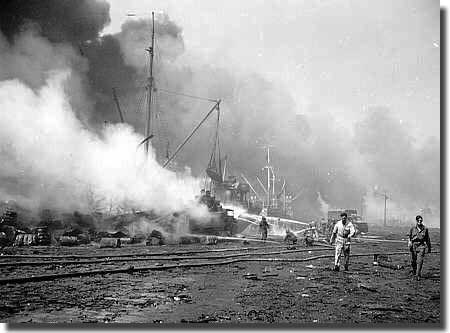|
Slaughter at Bari, Southern Italy. 2nd. of December 1943
Introduction. On the 2nd. of December 1943, the port was crowded with 30 Allied ships. One of these, the Liberty ship John Harvey, carried a secret load of 100 tons of mustard gas bombs, a precaution in case Hitler decided to invoke the use of chemical warfare. The seeds of the ensuing disaster were planted, merely waiting to germinate.
The Port of Bari, all hustle and bustle. Come sunset, on the evening of the 2nd. of December in 1943, with the urgent need to hasten the unloading of ships filling the port, the harbour was brilliantly lit so that cargo might be unloaded thoughout the night. German reconnaissance flight during the afternoon of the 2nd. of December 1943. Field Marshal Wolfram von Richthofen, in command of Luftflotte 2, had suggested to his boss, Field Marshal Kesselring, that an attack on Bari could slow down the advancing 8th. Army, and retard attacks from the newly arrived US 15th. Air Force. He thought he might manage to gather 150 JU 88's for the attack, in the event, 105 was all he could muster. His aircraft were ordered to fly east to the Adriatic, then turn and approach Bari to the west, the Allies no doubt would anticipate any German air raids to come in from the North. The aircraft would drop Duppel, thin strips of tin foil to confuse the defensive Radar. Parachute flares would be dropped to light up the targets in the harbour at about 1930 ( 7.30 PM , ) then the JU 88's, would attack at a low altitude, hoping to avoid Allied Radar installations.
Mustard gas in Liberty Ship SS John Harvey. Mustard gas forms blisters, irritates the respiratory system, leaving the skin burnt, with raw ulcers. Post WW2, in the Royal Australian Navy, I was undertaking an Atomic, Biological, Chemical, Damage Control course at a Sydney NavalEstablishment, during which I was instructed how to combat the effects of mustard gas. Some of this deadly chemical was introduced onto the back of my hands, I was certainly pleased I had paid attention on how to nullify it working, as I diligently scrubbed it off my hands to negate any ill effects of this awful weapon of war. Fortunately I was On board John Harvey, 1st. Lieutenant Howard D. Beckstrom and his six man team from the 701st. Chemical Maintenance Company were on hand in case of trouble from this deadly cargo. The ship had crossed the Atlantic Ocean without running into any U-Boat problems, then had stopped at Oran in Algeria, thence to Augusta in Sicily, until it made it into Bari on the 26th. of November. Her cargo including 2,000 M47A1 gas bombs filled with mustard gas, which remained a secret, meant she was not given any priority to unload, she must wait her turn. The German air attack.
The attack was a complete suprise, Liberty Ship Joseph Wheeler exploded from a direct hit, John Motley was hit in No. 5 hold, John Bascom next to her, shattered by a rain of bombs, was abandoned. John Harvey on fire, suddenly blew up, disappearing in a mighty fireball, casting pieces of ship and her deadly cargo of mustard gas all over the harbour. Mustard gas gives off a garlic odour, and now it combined with oil in the harbour, a deadly and volatile mixture. People were noticing a smell of garlic in the air, already doing its deadly work. Another Liberty ship, Samuel Tilden was sunk. In all, 17 ships were lost, 5 American, 5 British, 2 Italian, 3 Norwegian, and 2 Polish, another 7 were heavily damaged. Here is a list of the 17 ship losses and those damaged in the raid.
Heavily damaged ship list.
Casualties. The port was closed for three weeks, it had been rendered into rubble. Secrecy about the mustard gas. No doubt his insistence of secrecy could have caused more deaths, as victims, especially Italian civilians might have sought proper treatment for their injuries, had they known the real cause. Conclusion. The Bari raid produced the only poison gas incident associated with WW2, made worse by the perceived need for secrecy in wartime.
*Photographs attributed to an unknown photographer. |




